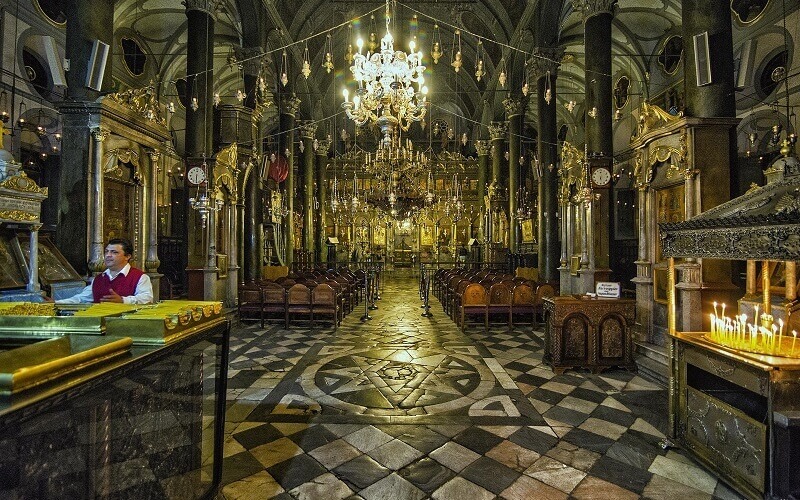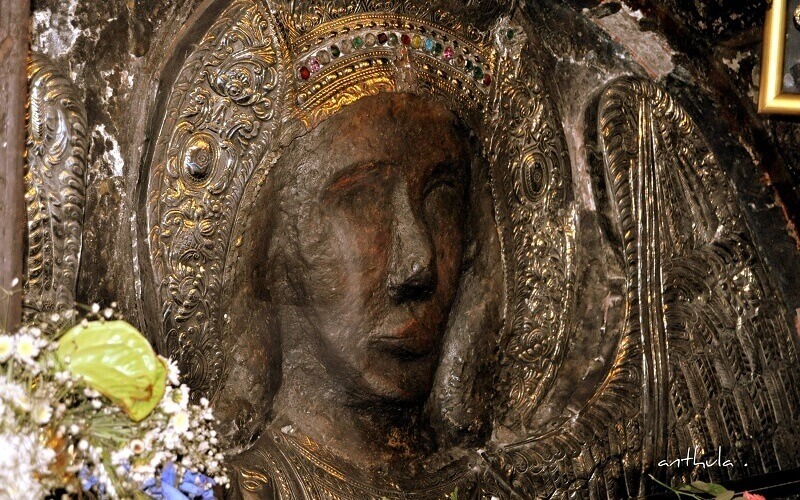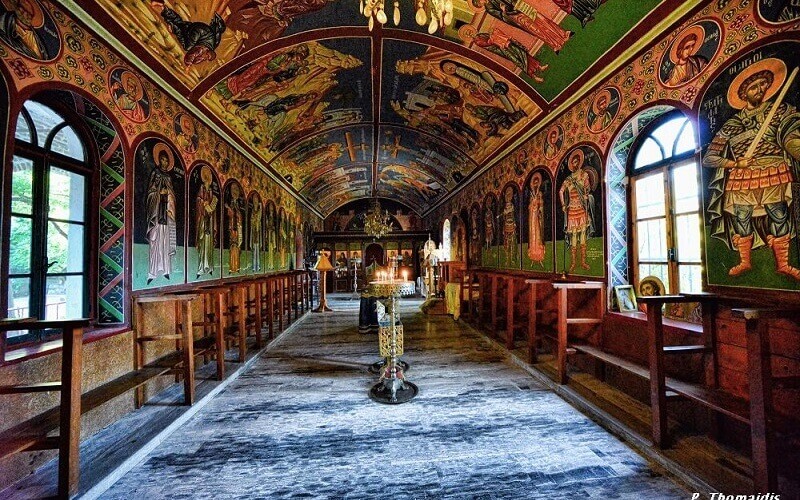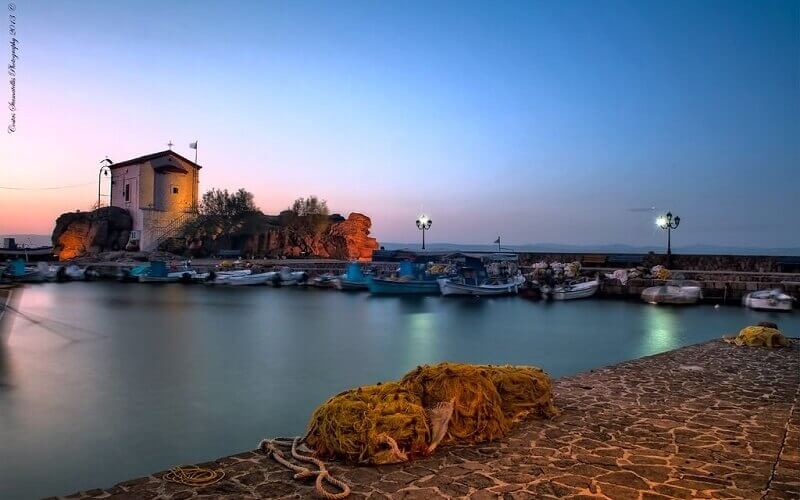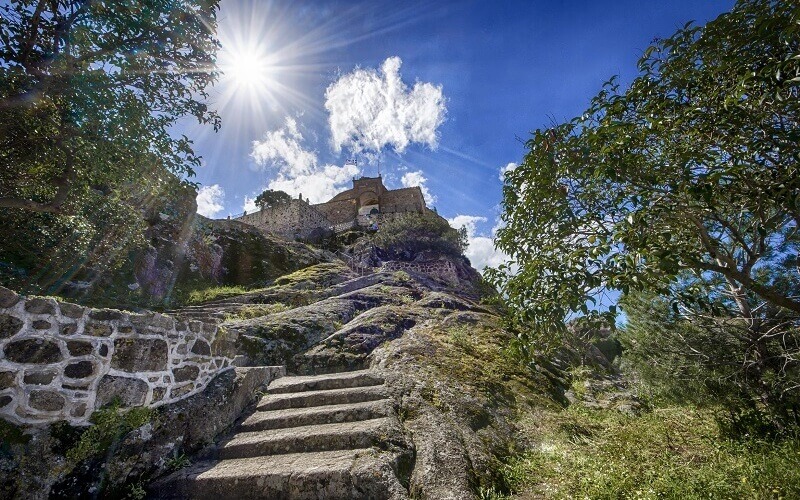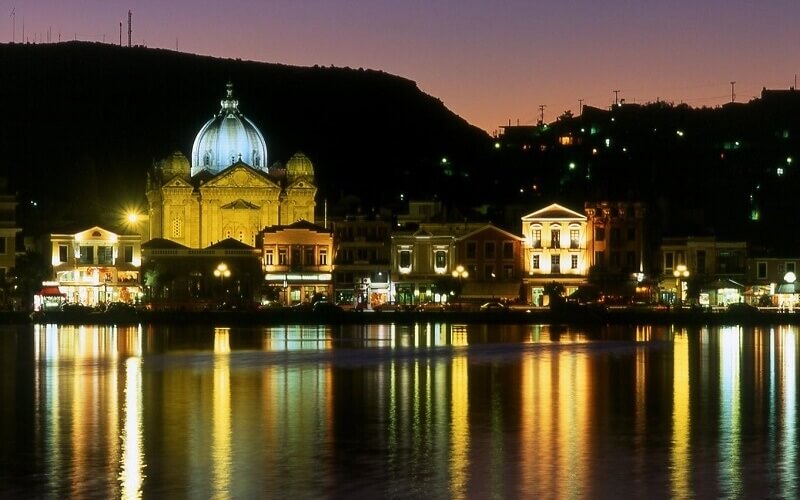Lesvos, with a long ecclesiastical history and a monastic past dating back to the Byzantine era, is a unique destination for those who have a special interest in religion and spirituality, but also for the travelers who are eager to learn about the history and civilization of the place they visit through its religious monuments. Imposing monasteries, places of worship and pilgrimages, as well as humble chapels scattered all over the island, represent the island’s great religious past and present.
Churches
The church of Agios Athanasios which is the metropolitan church of Mytilini since at least the beginning of 18th c., is located at the centre of the old settlement of Mytilini and is distinguishable from a long distance, due to its 33m high gothic style bell-tower which was erected in 1882. It is a domed cross-in-square basilica with three aisles and an exquisite altarpiece. Its interior decoration consists mainly of wood carving and naturalistic murals. The relics of Saint Theodoros of Byzantium are enshrined in the church for more than two centuries. The oldest testimony about this temple dates back to early 18th c. referring to its renovation, indicating that it was already a metropolitan church long before then.
Source: http://immyt.net/diocese/naoi_mytilene1.htm
The church of Agioi Theodoroi is located at a small distance from the metropolitan church of Agios Athanasios. It is a three-aisled basilica with the roof of the middle aisle elevated and it was built in 1795 to replace an older church which had been completely destroyed by fire. During that fire, the archives of the church were also lost, having as a result to have no knowledge about the period before 1795. It is believed that the previous church was the metropolitan church of Mytilini, at least for some time after Lesvos’ occupation by the Ottomans.
Source: http://immyt.net/diocese/naoi_mytilene2.htm
 The church of Agios Therapon dominates the city of Mytilini owing to both its impressive mass but mainly to the originality of its architectural type. The erection of this monument commenced in the beginning of the 19th century by the flourishing at that time Christian quarter and was completed in 1935. The architect was Argyris Adalis, Ziller’s student. The architectural order follows the cross-in-square type; however, the monument constitutes a combination of elements from contemporary architectural trends that prevailed in the West (Baroque, Rococo, Neoclassicism etc.). Gothic elements are prevalent as well, adding an impressiveness and a distinctive style to the monument.
The church of Agios Therapon dominates the city of Mytilini owing to both its impressive mass but mainly to the originality of its architectural type. The erection of this monument commenced in the beginning of the 19th century by the flourishing at that time Christian quarter and was completed in 1935. The architect was Argyris Adalis, Ziller’s student. The architectural order follows the cross-in-square type; however, the monument constitutes a combination of elements from contemporary architectural trends that prevailed in the West (Baroque, Rococo, Neoclassicism etc.). Gothic elements are prevalent as well, adding an impressiveness and a distinctive style to the monument.
Source: http://immyt.net/diocese/naoi_mytilene3.htm
The church of Taxiarches of Kagiani was built in 1903, in the place of a previous smaller temple. It is dedicated to Archangels Michael and Gabriel, called Taxiarches. In 1936 the name of the church was officially also given to the whole village, which until then was called Kagiani. The church prevails at the area of the south part of Mytilini with its impressive dome, and presents many similarities with the church of Agios Therapon in Mytilini, as their architect was the same, Argyris Adalis. It is a cross-in-square church with several gothic influences. In the temple there is a significant collection of heirlooms, among which an elaborate Sanctification Cross.
Source: http://immyt.net/diocese/naoi_perioxi1.htm
 The church of the Dormition of the Virgin (Koimisis of Theotokos) known as “Panagia of Agiasos” is one of the most visited churches on the island, due to its miraculous icon of Virgin Mary. It was originally built in the Byzantine period with a history starting from the period of Iconoclasm. The current church is a three-aisled basilica, impressive for its size (32.20m length and 26.20m width). The most important heirloom is the icon of Panagia (Virgin Mary) which according to the tradition, was brought from Jerusalem by Agathon. At the church’s courtyard you will find a small ecclesiastical museum operating since 1972, with a rich collection of portable icons, manuscripts, incunabula, gold embroidered surplices, ecclesiastical artifacts and many other valuable pieces. The church is celebrated on 15th August when crowds of pilgrims arrive at the village to worship Virgin Mary. During the first half of August many people from all over the island come to attend the evening invocations to Virgin Mary. On the eve of its celebration day, it is a custom for the island’s inhabitants to visit Agiasos from their villages on foot.
The church of the Dormition of the Virgin (Koimisis of Theotokos) known as “Panagia of Agiasos” is one of the most visited churches on the island, due to its miraculous icon of Virgin Mary. It was originally built in the Byzantine period with a history starting from the period of Iconoclasm. The current church is a three-aisled basilica, impressive for its size (32.20m length and 26.20m width). The most important heirloom is the icon of Panagia (Virgin Mary) which according to the tradition, was brought from Jerusalem by Agathon. At the church’s courtyard you will find a small ecclesiastical museum operating since 1972, with a rich collection of portable icons, manuscripts, incunabula, gold embroidered surplices, ecclesiastical artifacts and many other valuable pieces. The church is celebrated on 15th August when crowds of pilgrims arrive at the village to worship Virgin Mary. During the first half of August many people from all over the island come to attend the evening invocations to Virgin Mary. On the eve of its celebration day, it is a custom for the island’s inhabitants to visit Agiasos from their villages on foot.
Source: http://immyt.net/diocese/naoi_agiasos1.htm
 The church of Panagia Glykofyloussa (Sweet Kissing Virgin) is located in Petra and is built on a rock of about 40m high. To reach it, you must climb 114 stone steps. It is assumed that its erection took place during the period of frequent pirate raids of the Late Byzantine era, as it is suggested by its fortified location. It is a three-aisled basilica with narthex, rare Byzantine icons and a wood carved episcopal throne of exceptional beauty. It is assumed that a small temple had been found at the same location since 15th c. In 17th c. a bigger church with cells was erected there. The renovation of the church in its present form was undertaken in 1840 by the master builder from the village of Anemotia, Stratis Karekos, with a sultan’s decree. It is a major place of worship which attracts many visitors, especially during the service on Holy Friday and the procession of the epitaph. Very close and in the same region you will also find the church of Agios Nikolaos, a beautiful religious monument near the huge plane tree of the village. It is a basilica of the 17th c. with one aisle, in the murals of which the rare – and probably unique in a church – scene of Juda’s self-hanging stands out.
The church of Panagia Glykofyloussa (Sweet Kissing Virgin) is located in Petra and is built on a rock of about 40m high. To reach it, you must climb 114 stone steps. It is assumed that its erection took place during the period of frequent pirate raids of the Late Byzantine era, as it is suggested by its fortified location. It is a three-aisled basilica with narthex, rare Byzantine icons and a wood carved episcopal throne of exceptional beauty. It is assumed that a small temple had been found at the same location since 15th c. In 17th c. a bigger church with cells was erected there. The renovation of the church in its present form was undertaken in 1840 by the master builder from the village of Anemotia, Stratis Karekos, with a sultan’s decree. It is a major place of worship which attracts many visitors, especially during the service on Holy Friday and the procession of the epitaph. Very close and in the same region you will also find the church of Agios Nikolaos, a beautiful religious monument near the huge plane tree of the village. It is a basilica of the 17th c. with one aisle, in the murals of which the rare – and probably unique in a church – scene of Juda’s self-hanging stands out.
The church of the Virgin (Panagia) Troulloti is built in the area of Ano Pyrgoi at Thermi, in the eastern part of Lesvos, only 10 km from the city of Mytilini. The church belongs to the type known as domed cross-in-square and dates in the 14th century. It constitutes one of the few Byzantine churches preserved on Lesvos. Architectural members from more ancient buildings are incorporated in the masonry of the monument, two of which are marble relieves of particular interest in the south wall of the narthex. These two relieves are ornamented with both human figures as well as animal ones (such as that of a bear or a deer) and they were probably taken from the nearby sanctuary of Artemis Thermia. The interior of the church is decorated with wall paintings that date after its foundation and are only partially preserved. Its wood carved templon dates in the mid-18th century and constitutes one of the most exquisite samples of post-Byzantine wood carving on Lesvos.
Source: http://odysseus.culture.gr/h/2/gh251.jsp?obj_id=1722
 The temple of Agios Stefanos is found at the site Palios at the beach of Mantamados. It belongs to cross-in-square temples. Its dome had already collapsed when Νewton visited it in the mid-19th century, and it was replaced by wooden beams covered with tiles. The portico in the west of the temple is a later addition of the 20th century. It is a small building of cut stones of pinkish trachyte. Architectural parts of an earlier temple and an inscription have been walled in the masonry of the monument. At the eastern part, the three semicircular arches of the chancel stand out, while blind arches adorn the north and south wall. The floor of the interior is pebbled with various decorative motifs. It is difficult to determine the monument’s dating. However, according to its form, it should be placed in the 13th century. In some parts of the monument, there are remnants of mural paintings, which however cannot be dated.
The temple of Agios Stefanos is found at the site Palios at the beach of Mantamados. It belongs to cross-in-square temples. Its dome had already collapsed when Νewton visited it in the mid-19th century, and it was replaced by wooden beams covered with tiles. The portico in the west of the temple is a later addition of the 20th century. It is a small building of cut stones of pinkish trachyte. Architectural parts of an earlier temple and an inscription have been walled in the masonry of the monument. At the eastern part, the three semicircular arches of the chancel stand out, while blind arches adorn the north and south wall. The floor of the interior is pebbled with various decorative motifs. It is difficult to determine the monument’s dating. However, according to its form, it should be placed in the 13th century. In some parts of the monument, there are remnants of mural paintings, which however cannot be dated.
Source: http://odysseus.culture.gr/h/2/gh251.jsp?obj_id=15681
 The picturesque chapel of Panagia Gorgona (Virgin the Mermaid) is found in Skala of Sykamnia, on a strip of land into the sea. Panagia Gorgona – the Virgin of seafarers – took its name after the characteristic wall painting of an unknown folk painter, representing Virgin Mary having a mermaid tail, a work indicating a genuine combination of religion and tradition. This small church inspired the famous writer from Lesvos, Stratis Myrivilis, to write the homonymous piece of literature.
The picturesque chapel of Panagia Gorgona (Virgin the Mermaid) is found in Skala of Sykamnia, on a strip of land into the sea. Panagia Gorgona – the Virgin of seafarers – took its name after the characteristic wall painting of an unknown folk painter, representing Virgin Mary having a mermaid tail, a work indicating a genuine combination of religion and tradition. This small church inspired the famous writer from Lesvos, Stratis Myrivilis, to write the homonymous piece of literature.
Monasteries
 The monastery of Pammegiston Taxiarchon in Mantamados is situated at a close distance from the village Mantamados, in the north-east part of Lesvos, 36 km from Mytilini and it constitutes one of the most significant places of pilgrimage on the island. In the past, it functioned as men’s convent and is mentioned for the first time in an ecclesiastical document from 1661.
The monastery of Pammegiston Taxiarchon in Mantamados is situated at a close distance from the village Mantamados, in the north-east part of Lesvos, 36 km from Mytilini and it constitutes one of the most significant places of pilgrimage on the island. In the past, it functioned as men’s convent and is mentioned for the first time in an ecclesiastical document from 1661.
The small church of the 17th century was replaced with a bigger one of the 18th century, in the place of which the present church was erected from top to bottom in 1879, following the architectural type of the three-aisled basilica.
The monastery complex develops parametrically around the church, adding a fort-like character to it. In the church’s interior and, more specifically, in a luxurious canopy from 1766, the wrought-in-relief icon of Taxiarches is kept, which -according to tradition- was made with soil and the blood of the monks who were slaughtered by pirates.
Of folklore interest is the custom of the bull’s slaughter, which takes place on the anniversary of the church’s inauguration.
Source: http://odysseus.culture.gr/h/2/gh251.jsp?obj_id=1841
The monastery of Agioi Rafael, Nikolaos and Eirini is found at a location of a previous Byzantine monastery which was completely ruined by the Ottomans in 1463. The three saints, along with many inhabitants of the region of Thermi, martyred during an Ottomans’ raid, as retaliation to a local upheaval which caused the rage of the invaders.
The monastery was officially founded with a presidential decree in 1963, exactly five hundred years after their martyrdom. On 11th September 1970 the Ecumenical Patriarchate declared Rafael, Nikolaos, Eirini and their companions as Saints. The three Saints’ tombs are found at the two churches in the monastery. In a very short time after its establishment, the monastery became one of the most important pilgrimages of Orthodox religion, due to the plethora of miracles by Saint Rafael.
Source: http://immyt.net/diocese/mones/mones2.htm
 The monastery of Pammegistoi Taxiarches in Eresos is known as Monastery of Pythari (pythari means clay jar) and took its name after the geomorphology of the site: the monastery is built at a hollow of a ravine, surrounded by hills forming an imaginary jar, the bottom of which has been turned into a reservoir with a nearby artificial dam. There has been a dispute over its foundation, due to the absence of relative historical evidence. According to some researchers, it was a Byzantine monastery reestablished during the Turkish dominion, while others believe that its foundation dates back to 16th century. The certain is that it was already in operation in 1548, a date that appears in an Ottoman record book where there are reports about the monasteries’ fiscal obligations of the district of Eresos. The sum of money that the monastery had to pay indicates its great wealth, probably suggesting that it had been founded some decades earlier.
The monastery of Pammegistoi Taxiarches in Eresos is known as Monastery of Pythari (pythari means clay jar) and took its name after the geomorphology of the site: the monastery is built at a hollow of a ravine, surrounded by hills forming an imaginary jar, the bottom of which has been turned into a reservoir with a nearby artificial dam. There has been a dispute over its foundation, due to the absence of relative historical evidence. According to some researchers, it was a Byzantine monastery reestablished during the Turkish dominion, while others believe that its foundation dates back to 16th century. The certain is that it was already in operation in 1548, a date that appears in an Ottoman record book where there are reports about the monasteries’ fiscal obligations of the district of Eresos. The sum of money that the monastery had to pay indicates its great wealth, probably suggesting that it had been founded some decades earlier.
Source: http://immyt.net/diocese/mones/mones4.htm
 The monastery of Perivoli is situated in a by-passing of the country road Kalloni-Antissa, just before the village of Antissa on the banks of the Voulgaris river. It is a women convent dedicated to the Presentation of the Virgin and it was devastated in recent years. In the past (at least from the 16th up to the end of the 18th century), it constituted part of the men’s monastery of Taxiarches Kreokopou, which is located at approximately an hour’s distance from Perivoli, on the top of Mt Chalakas. The katholikon (main church) of the monastery is built according to the type of a two-aisled wooden roof basilica; it is of small dimensions with remarkable frescoes that date in the 16th century.
The monastery of Perivoli is situated in a by-passing of the country road Kalloni-Antissa, just before the village of Antissa on the banks of the Voulgaris river. It is a women convent dedicated to the Presentation of the Virgin and it was devastated in recent years. In the past (at least from the 16th up to the end of the 18th century), it constituted part of the men’s monastery of Taxiarches Kreokopou, which is located at approximately an hour’s distance from Perivoli, on the top of Mt Chalakas. The katholikon (main church) of the monastery is built according to the type of a two-aisled wooden roof basilica; it is of small dimensions with remarkable frescoes that date in the 16th century.
Source: http://odysseus.culture.gr/h/2/gh251.jsp?obj_id=1842
 The monastery of Taxiarches Leimonos is located in a fertile basin at the centre of Lesvos, 14 km northwest of Kalloni. The Monastery had been established during the Byzantine years and stopped functioning possibly in the late 15th c. The bishop of Mithymna, Ignatios, reestablished the monastery in 1527 and founded a school which contributed to the monastic revival in Lesvos. The devotional complex of the monastery includes buildings from various eras. The main church building at the central precinct is a three-aisled basilica with elevated middle aisle. It was built in 1795 at the location of an older one and has incorporated five chapels. The earlier phase of its murals, made by the monk Nikiforos from Holy Mount Athos, dates in 1800. The murals’ iconographic programme of the sacristy (crypt) at the eastern part of the temple presents a great interest. The monastery’s cemetery is found outside of the precinct. Murals from the 16th c. are saved at the cemetery’s temple. The monastery’s collections include icons, embroidered surplices and fabrics, ecclesiastical objects, folklore heirlooms as well as rock specimens from all over Lesvos. The library of the monastery is also very important, including manuscripts and printed books as well as an Archive of Greek and Ottoman documents.
The monastery of Taxiarches Leimonos is located in a fertile basin at the centre of Lesvos, 14 km northwest of Kalloni. The Monastery had been established during the Byzantine years and stopped functioning possibly in the late 15th c. The bishop of Mithymna, Ignatios, reestablished the monastery in 1527 and founded a school which contributed to the monastic revival in Lesvos. The devotional complex of the monastery includes buildings from various eras. The main church building at the central precinct is a three-aisled basilica with elevated middle aisle. It was built in 1795 at the location of an older one and has incorporated five chapels. The earlier phase of its murals, made by the monk Nikiforos from Holy Mount Athos, dates in 1800. The murals’ iconographic programme of the sacristy (crypt) at the eastern part of the temple presents a great interest. The monastery’s cemetery is found outside of the precinct. Murals from the 16th c. are saved at the cemetery’s temple. The monastery’s collections include icons, embroidered surplices and fabrics, ecclesiastical objects, folklore heirlooms as well as rock specimens from all over Lesvos. The library of the monastery is also very important, including manuscripts and printed books as well as an Archive of Greek and Ottoman documents.
Source: http://odysseus.culture.gr/h/2/gh251.jsp?obj_id=1840
http://84.205.233.134/index.php
The female monastery of Panagia (Virgin) Myrsiniotissa is found near the monastery of Leimonas, at the location of a deserted church, which was historically the katholikon (main church) of the Byzantine monastery “Panagia of Myrsini”, as referred in a patriarchal document of 1331 A.D. It is a Byzantine convent also reestablished by saint Ignatios Agallianos in 1523. During the Turkish occupation the young girls of the region attended a school of weaving and embroidery operated there. The church was completely burned down by a fire in 1915. However, the Byzantine icon of Panagia Myrsiniotissa was saved from the fire. The exterior of the church was restored as a basilica, while its interior bears the elements of Βyzantine domed cross-in-square with loft. Besides its long history, the monastery offers to visitors the heavenly peacefulness of the monastic environment and the colourful serenity of its flowery courtyard.
Source: http://84.205.233.134/ignatios.php
The monastery of Agios Ioannis Theologos, a male convent, is built on the top of the mount Odyrmnos at a height of 634 m at western Lesvos and since 18th c. it is known as the monastery of Ypsilos (ypsilos means high), due to its location. Its fortress like architecture, with crenellations and a fortified tower, gives the impression that the monastery was forced to defend itself many times throughout the centuries and offered shelter to the inhabitants of the nearby region during raids. It is believed that it was founded during the Byzantine years before 800 AD. but it was deserted in the Late Byzantine years. It thrived again in post Byzantine years, but in 1967 the church’s interior was destroyed by fire. The present katholikon (main church) was built in 1832 as part of a typical monastic complex developed around it.
The monastery has a remarkable historical library with manuscript codices, liturgical scrolls, record books and dozens of incunabula. Its museum is also very interesting, where valuable historical artifacts and portable icons of Byzantine style of 16th and 17th c. are exhibited.
Source: http://immyt.net/diocese/mones/mones1.htm
http://odysseus.culture.gr/h/2/eh251.jsp?obj_id=1843
The monastery of Damandri is situated in the area of Polichnitos and was founded in post-Byzantine years, at an era during which numerous churches and monasteries were founded on the island. The monastery’s katholikon (main church) is dedicated to the Dormition of the Virgin and belongs to the type of a single aisled basilica. The name “Damandri” is taken from a small Byzantine village, the ruins of which are very close to the monastery; the village in question is mentioned in a Metropolis Codex from 1567 to 1652. The church’s wall paintings, which date in the 18th century (1733), were made by the painter Chomatzas. The wood carved templon dates in the late years of the Turkish occupation, whereas the icons of Christ and the Virgin Hodegetria in the 16th and 17th century.
Source: http://odysseus.culture.gr/h/2/eh251.jsp?obj_id=893
The monastery of Taxiarches of Kato Tritos at the region of Gera is the only monastic complex of the Byzantine era saved on Lesvos. The katholikon (main church) of the monastery is built at a flat area on the top of an olive-covered hill with exquisite view to the Gulf of Gera and is surrounded by deserted cells and ancillary areas. There are no written testimonies about the monastery. The small single space church is a not fully developed cross-in-square church with dome. Its erection is estimated in Late Byzantine years. In its interior two layers of mural decoration are saved. Most of its murals date back to 17th century. Two parts of the church’s wood carved altarpiece are exhibited today at the Ecclesiastical Museum of Mytilini.
Source: http://odysseus.culture.gr/h/2/eh251.jsp?obj_id=5821


 Greek
Greek